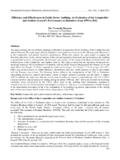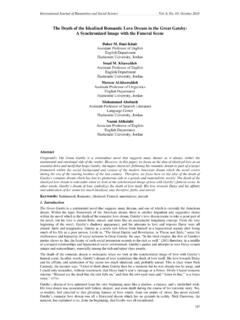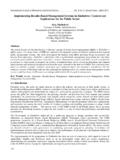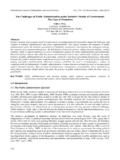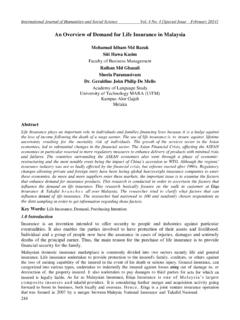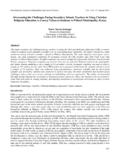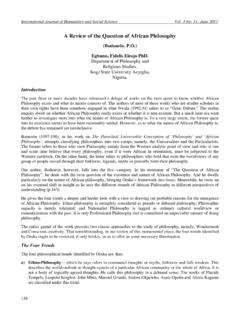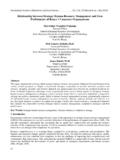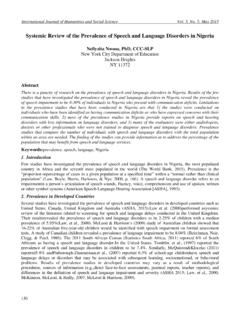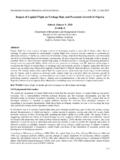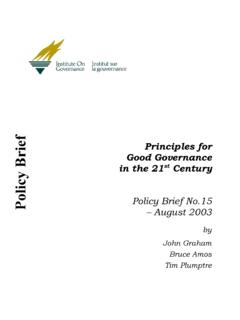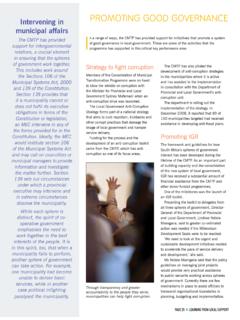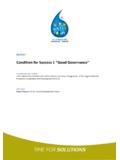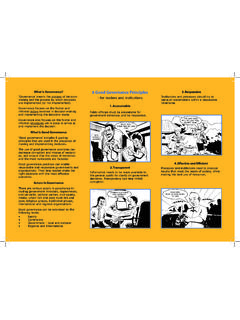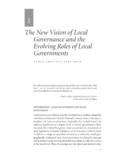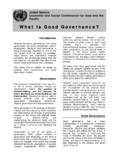Transcription of Sustainable Development and the Role of Local …
1 International Journal of Humanities and Social Science Vol. 4 No. 1; January 2014 268 Sustainable Development and the Role of Local governance : Experience from Malaysian Model Regions Ashiru Bello Kamariah Dola Faculty of Design and Architecture Universiti Putra Malaysia Abstract In this article, conceptual issues regarding Local governance and its utility in pursuing Sustainable Development goals have been discussed. Drawing from some good practice examples globally, and the existing situation in some East Asian countries, we concluded by examining the Malaysian situation of Local governance in the midst of quest for Sustainable Development .
2 Learning from the two models for Sustainable Development in Malaysia (Putrajaya and Iskandar), we contend that in spite of the administrative limitations associated with Local governance in Malaysia (for example, Local political actors being appointed by the ruling party), Local governance institutions can still achieve a lot with regard to the attainment of Sustainable Development targets. This is supported by the business as usual emission scenarios based on current practices, particularly in Putrajaya. Much is however needed in improving the Local administrative capacities, as the relative progress is invisible at the national scale. Keywords: Sustainability, good governance , rationality, Putrajaya, Iskandar Malaysia.
3 Introduction The organic pattern in which human societies evolved throughout history became in need of a steering force upon man s realization of the necessity for drifting from the normal path of economic rationality. Being rational according to Olson (2009) means that, men behaves selfishly and only become interested in common public good if potentials exist for individual interests to be fulfilled. This notion inspired the idea of co-benefits in dealing with complex environmental issues. The resulting effect of the earlier described normal path of economic rationality whether at the level of individuals, communities and even nations proved so far to be unsustainable and possesses such feedbacks that are unwanted even to those individuals, communities or nations that may seem to be benefitting from the status quo or business as usual.
4 Regardless of how it is going to be achieved, it is clear that a somehow irrational behaviour is required for the seemingly all-loving sustainability of civilization to even be pursued. The steering force required to achieve a balance between the rational normal human trait (which conflicts with Sustainable Development ) and the irrational trait of acting for public good, is attained through governance . Committed (often few) individuals within societies have to shoulder the responsibility of working out this equilibrium. This complex struggle characterizes the ideal role of governance institutions. Whether we consider the physical environment or the socio economic issues together or in isolation with regard to Sustainable Development , Local governance has an important role to play in working out those approaches that will lead to the equilibrium between rational and irrational traits of man.
5 For example, in some less developed economies where the flora is naturally scanty, it is common to find out that the existing flora suffers great destruction from being targeted as an energy source. This is obvious where the other fragile energy options are either absent or inaccessible. Again, in most of these situations, the existing scenarios are not disconnected from issues of governance . Center for Promoting Ideas, USA 269 Figure 1 Local governance in flora conservation: an example Left alone without some guiding force , we tend to act rationally, and often produce negative environmental and social impacts.
6 Mazerolle et al (2002) for example, reported how peoples awareness of CCTV presence influences their rational social behaviour in public space. Publishers and academic institutions today do not only detest researchers from plagiarism by informing them of its bad effects, they also try to make them aware that there is a checking instrument to detect text similarity. To find out and implement workable incentives to attract humans away from their unsustainable rational traits, good Local governance is a necessity. Fortunately, humans have this ability to learn and adopt the irrational trait over time. That balance is therefore achievable. In this paper, the policy provisions in the Malaysia s National Physical Plan as well as the National Urbanization Policy have been examined, and concluded with Sustainable Development efforts (with particular reference to emissions control) in the two model regions of Putrajaya and Iskandar Malaysia.
7 Sustainable Development It is not only difficult to have a precise definition for Development when it is married to sustainability, but that same difficulty will confront anyone trying to define the two terms in isolation. While some scholars view the term Sustainable Development to be too vague and ambiguous, and therefore open to wide range of interpretations (Adams, 2001; Stirling 1999), some simply consider it to be a host for a number of myths (Lemonick 2009; Lunghurst 2006 and Allen 2001). The ubiquitous nature of the term according to other scholars (such as Torgerson 1995) is an advantage that gives Sustainable Development wider application.
8 The classical definition from the Brundtland (1987) report which viewed Sustainable Development as a Development that meets the need s of the present without compromising the ability of future generations to meet their own needs (WCED 1987: 47), is not far away from the focus of numerous other contemporary definitions despite its criticisms. One may ask for example, how about if the future generation happens to be uninterested in what the past conserves, since their needs could be quite different from those of the present? While many scholars recognised the need to have a deliberate attempt in reviewing the pattern of relationship that exists between man and surrounding eco system, man s limitations in long term forecasts and level of scientific understanding of existing simulation models can lead to a second thought about many of the practices we may declare Sustainable .
9 Khan (2013) writes that, although the need for drastic reduction of climate gas emissions as the overarching goal of a low carbon transition is agreed upon, how these goals can be achieved an the implication for cities are open to contestation. Mechanized farming for example, share similar long term uncertainties with the production of ethanol for fuel from farmlands, particularly in terms of feedbacks as well as calorie input and output. The goal of living sustainably according to Lemonick (2009) requires continuous and large amount of thoughts. Difficulty in explaining Development and its sustainability have not however deterred its growing usage (Dola, 2006). Two principles can generally be deduced from the many definitions of Sustainable Development .
10 They are the social equity principle and that of environmental precaution (Dola, 2003). On a cross sectional basis, Development should entail the promotion of social equity, and at the same time be conscious of the critical natural capital that is essential to human survival on a longitudinal basis. Related to these basic principles are the three dimensions of Sustainable Development . Absence/inaccessibility of better energy options Existing flora as an energy source Environmental quality degradation Local governance Ensure availability and access to options Enforce forest conservation measures Implement adaptation strategies International Journal of Humanities and Social Science Vol.
